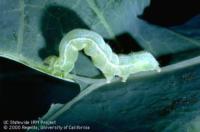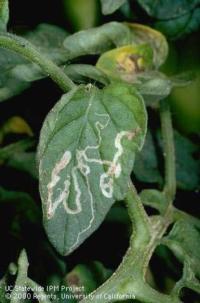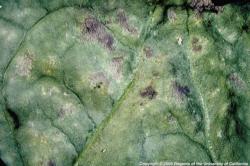Spinach, problems
-
Caterpillars
Spinach and other leafy vegetables can be plagued by caterpillars. A common type of caterpillar on greens is a looper.
Loopers are light green caterpillars that completely or partially eat leaves of vegetable plants. These caterpillars are the larvae of variuos moths; the most common is the cabbage looper.Control
Handpick caterpillars off leaves and destroy. Use row covers or netting to prevent moths or butterflies from laying eggs. There are many natural enemies of caterpillars, so it is important not to use a broad spectrum insecticide which will kill the beneficials.If damage is extensive, Bacillus thuringiensis (Bt) or spinosad, both bacterial-based insecticides, are effective against loopers, especially when caterpillars are small.
Bt works when it is eaten by the caterpillars, so should be applied to leaf surfaces where you see caterpillars feeding. Bt is not effective against eggs or adults, so it should be used as soon as you see small caterpillars, and then reapplied in a few days to treat the newly hatched.
Spinosad also works best when ingested although it also works on contact with the caterpillar. It also works best when the caterpillars are small and can be reapplied in a few days to treat the newly hatched.
Read more about caterpillars in the garden.
Leafminers
If your spinach leaves have light green to yellow blotches, then the problem may be the larvae of leafminers. They make tunnels in the undersides of leaves causing the discolorations. You can pull open the blotch area and find these larva.
Pick off and destroy these infested leaves. Read more about leafminers in the vegetable garden.
Poor seed germination
If your spinach seeds do not germinate well, the most likely cause is that the soil temperatures are too high. Spinach is a cool-season vegetable and prefers soil temperatures to be between 50 and 60 degrees F.
Yellowing leaves
If the spinach leaves become faded yellow, the plant could need more nitrogen. Fertilize with a nitrogen-containing fertilizer. Overwatering can also cause yellowing of leaves.
Downy MildewIf your spinach leaves develop pale green areas with fluffy gray spores on the undersides, then the plant probably has downy mildew. The problem gets worse when weather is wet and humid or if the leaves stay wet from frequent watering.
Be sure and plant resistant varieties. Remove all plant debris when you harvest or remove plants. Rotate your crops, especially if you are having fungal problems.
Read more about downy mildew.



